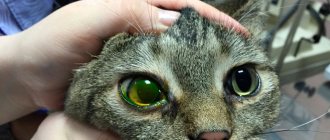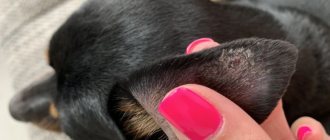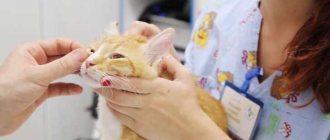The cat's body is well adapted to external conditions, is quite resistant to infections and is able to quickly cope with some painful conditions. But all this is provided that the animal eats well and has not suffered a serious illness that weakened the immune system.
Domestic cats are almost free from the risk of severe infectious disease if the owner is prudent: annually takes the pet to the veterinary clinic, where it is examined and vaccinated. The decisive factor for a long and happy cat's life is the ban on free walking.
Unfortunately, even a very responsible and attentive owner can overlook the initial stage of the disease: the coat, often thick and long, hides the first symptoms that appear on the skin. Many diseases (not only infectious ones) manifest themselves as slight redness and swelling on different parts of the body, including the mucous membranes - for example, on the lips.
Although these areas are not covered with hair, the hairs of the chin and chin cover them. The matter is complicated by the fact that cats are very patient. And when the owner notices ulcers on the cat’s lips, nervous behavior or loss of appetite, this indicates that the process has gone quite far.
Reddened swellings, sores and ulcers can indicate many diseases, so only a veterinarian can make a diagnosis and prescribe treatment. Very often, several tests must be done to determine the cause of the disease.
Most often, ulcers indicate the following diseases and painful conditions.
Injuries
Cats are very curious: even a pet that has no chance of getting outside can find adventure in its face while exploring the apartment. A small wound (for example, when trying to bite a cactus - this happens!) will most likely heal quickly. However, for some time a small sore or ulcer will be noticeable in its place.
An animal may become interested in the stove or heater that has just been turned off, and get burned: the burn also leaves a mark in the form of a sore.
You might be interested in: Should I worry if my cat's whiskers fall out?
Discoloration of gums in cats - red, white, gray
Sometimes for therapy it is enough to eliminate contact with the allergen to restore the cat’s health. You will need to change food, dishes, and litter for the tray. During treatment, antihistamines and corticosteroids are used. The cat must be treated for parasites. The veterinarian can prescribe Suprastin, Diphenhydramine, Prednisolone. Therapy is carried out strictly under the supervision of a doctor, as adverse reactions may occur.
Based on materials from the website www.icatcare.org
Diseases affecting the oral cavity (mouth) and pharynx (pharynx) in cats are not uncommon. Such diseases are called oropharyngeal.
We suggest you read: Why the cat doesn’t go to the litter tray for a little while. Why do cats act like bullies?
The range of such diseases is quite wide, some of them are easily diagnosed and treated, while others are difficult to identify and treat. Some diseases are difficult to treat because the causes that cause them are not fully understood.
There are many signs that indicate that your cat has problems with the oral cavity or pharynx, including:
- Loss of appetite. The cat stops being interested in food, or goes to the saucer, but refuses to eat;
- Dysphagia. Swallowing disorder indicates difficulty eating or swallowing food—the cat eats with apparent caution, shows signs of discomfort, may drop food from its mouth, or has difficulty swallowing;
- Ptyalism is excessive salivation or drooling from the mouth (sometimes with bleeding);
- Halitosis is an unpleasant odor from a cat’s mouth;
- The cat scratches or rubs its mouth with its paws, sometimes shaking its head;
- Weight loss - usually due to lack of appetite;
A few days ago I noticed a clear redness of the cat’s lower lip, since she previously had only white fur in this place. I decided to take a closer look and examined it: I discovered a small swelling on the lower lip, similar to herpes in humans, with several small blisters. I went to the veterinarian, they took blood tests to rule out one of the diseases. They didn’t test for herpes (since it’s not done here, but done in Moscow). They prescribed Chlorhexidine and Metrogyl Denta. What could it be?
After going to the doctor in the cold, the swelling subsided a little.
The analysis confirmed the presence of the syndrome. There were 11 units in the blood (I may be wrong about how the quantity is measured) and leukocytes were very slightly elevated, all other indicators were normal. They prescribed Dexofort 0.5 subcutaneously every 8 days, and after the symptoms disappeared, as relapses appeared.
Thank you very much for the consultation.
Stomatitis is an inflammation of the oral mucosa. Very often, the disease goes unnoticed in the pet, which leads to too late contact with the doctor. Despite the apparent frivolity of the disease, stomatitis brings severe discomfort to the cat and can lead to tragic consequences.
The autoimmune type stands apart from all others - lymphocytic-plasmacytic stomatitis of cats; the disease is chronic and with massive damage, inflammation can even affect the pharyngeal mucosa.
In primary stomatitis, the most common cause of the disease is mechanical damage - when small bones from fish or meat get in, microtraumas of the mucous membrane occur, which lead to subsequent inflammation.
Thermal and chemical burns, as well as exposure to medications, can also be common causes.
We suggest you read: Treatment of diarrhea in a cat at home: medications, tips. What can you give a cat for diarrhea at home: medicines and folk methods
The occurrence of secondary stomatitis:
- Diabetes.
- Dental diseases – tartar, caries.
- Allergy.
- Fungal infections of the oral mucosa.
- Vitamin deficiency (in particular vitamin C deficiency) and metabolic disorders.
- Infectious diseases - plague, panleukopenia, calcivirosis and immunodeficiency.
The disease begins to develop gradually, with a catarrhal form. This stage is characterized by increased thirst, profuse salivation, a noticeable decrease in appetite, the cat eats very carefully and in small quantities due to pain when chewing. There is also a strong unpleasant odor from the mouth, and during examination of the mouth, redness of the mucous membrane and the presence of a grayish coating are noticeable.
After just a few days, the process worsens and develops into an ulcerative form. The animal's condition deteriorates sharply, the cat completely refuses to eat, and weakness is observed. Bright red ulcers appear on the gums in the mouth, and bleeding occurs when the mucous membrane is touched. Inflammation quickly takes over the entire mouth, teeth begin to loosen and fall out.
If treatment is not started at this stage, the process can spread to the jaw bones and even cause blood poisoning.
Then the gangrenous form begins:
- Swelling of the borders of the lips and decomposition of the tissues of the gums, palate and cheeks.
- Increased body temperature to high levels, apathy, weakness.
- The lymph nodes of the neck and lower jaw are enlarged.
- The smell from the mouth becomes foul.
The gangrenous form can quickly lead to the spread of the process to the jaw bones and a state of sepsis, as well as complete loss of teeth.
If a cat's lower lip is swollen, this may indicate mechanical damage or be the first sign of the development of cancer. For this reason, it is worth contacting a veterinary clinic in order to notice the pathology in time. When a cat or adult has a swelling or bump in the lip area, redness, swelling and inflammation are additionally recorded.
The color of the gums is a kind of litmus test that signals the health of your four-legged friend. It is the gums that are easy to see from any angle. To do this, all you need to do is lift your pet’s upper lip. Normally, a cat has elastic and pink gums. Any change in their color is a reason to take your pet to the hospital.
However, there are situations when the change in gum color is physiological and should not bother the breeder.
For example, in kittens up to 6 months of age, active teeth change occurs. In this case, the gums may not only be excessively red, but also swollen. Increased salivation is observed, and the animal may be restless. The breeder needs to show maximum attention to the pet: surround it with care and monitor the condition of the gums.
If there is any change in the color of the gums, you should take your pet to the vet. Many of the pathologies that are accompanied by a change in the color of visible mucous membranes are serious, some require long-term treatment or emergency care, and some can cause the death of a pet.
We invite you to familiarize yourself with: Toyger cats (photo): good-natured disposition in wild color
The veterinarian will help you correctly determine the cause of the color change and select adequate treatment. In some cases, an ultrasound, complete blood count, computed tomography or x-ray may be required for a more accurate diagnosis.
So, if a foreign body gets in and it is impossible to remove it mechanically, an emergency operation is performed.
For diseases of the oral cavity, ointments, sprays and solutions of medications are prescribed. The cat's mouth is treated with cotton swabs.
Injuries are treated locally, decongestants and cold compresses are prescribed to the site of bruises.
Changing gum color is always a cause for concern. Even a banal change of teeth in a kitten should not go unnoticed by the breeder.
And pathological conditions require mandatory consultation with a veterinarian; in some cases, a visit to the veterinary clinic can be very urgent.
For the speedy recovery of the animal, it is very important to strictly follow the specialist’s recommendations. Any medications should be administered only in the recommended dosage and not exceed it.
If your cat's gums are red due to oral diseases, then folk remedies can help. It is recommended to irrigate the mouth with decoctions of sage or oak bark after each meal. The procedure is performed using a syringe without a needle. You need to tilt the cat's head down so that it does not swallow the contents of the syringe.
To ensure that oral diseases bother your cat as little as possible, you need to regularly clean the mouth and teeth of plaque and tartar. To do this, use a soft toothbrush.
In case of diseases of the internal organs, it is necessary to normalize the cat’s daily menu, exclude harmful foods from it and supplement the diet with vitamins.
It is necessary to ensure that your cat always has fresh drinking water. The food in the bowl must also be extremely fresh.
If a cat has suffered swelling from an insect bite or a blow, or severe poisoning, then you should carefully monitor the animal’s further behavior. If symptoms of damage to internal organs or the oral cavity appear, you should contact your veterinarian again.
A change in the color of the mucous membrane of a cat's lips is an alarming symptom indicating an infection, an allergic reaction, or a malfunction of internal organs. If a cat has a black spot or several spots in the corners of its mouth that do not cause discomfort, acne is a possible cause. It is possible to accurately identify the cause of such spots only after laboratory tests and bacteriological examination of the composition of the mucous membrane.
Viral infections
Infection with herpes - this virus also affects cats - is a likely cause if a cat has an ulcer on his lip. This is a sign of a very dangerous disease - rhinotracheitis. It should be noted that this is far from the only symptom, and a good owner will quickly come to his senses and take the cat to the veterinarian.
Diagnosis of the disease is almost always difficult. Tests often give conflicting results, and symptoms are similar to some other diseases. Only an experienced veterinarian can diagnose rhinotracheitis. Animals that do not receive qualified care often die. It is impossible to cure it - after therapy, the virus only ceases to manifest itself. Fortunately, an effective vaccine against rhinotracheitis has long been created.
Feline herpes is not dangerous to humans, but quickly infects other cats: if there are several of them in the house, the sick animal must be immediately isolated.
Herpes in a cat
Thus, an ulcer on a cat’s lips may turn out to be herpes, the virus of which can infect not only people, but also animals. As a rule, if the cat is healthy and his body is strong, the pathogen behaves passively.
However, as soon as the pet’s immunity decreases, or the pet becomes ill with something, herpes appears in the form of sores on the lips (both upper and lower). They look like pink bubbles that periodically burst and become covered with a yellow crust.
Herpes on the lips brings severe suffering to the cat. It hurts and itches. The cat feels anxious, cannot eat normally, and tries to scratch the sore all the time. This contributes to its growth and deterioration of the condition as a whole.
If a sore similar to herpes is discovered, the pet must be taken to a veterinary clinic, where it will be examined, the necessary tests will be taken, a diagnosis will be made and treatment will be prescribed. The disease in cats does not always go away on its own. Often the consequences of a sore on the lip are rhinotracheitis, which manifests itself :
- constant sneezing;
- secretion of mucus from the nasal tract, which gets into the cat's eyes, causing them to stick together;
- increased temperature;
- weakness;
- lack of appetite.
Rhinotracheitis is considered a dangerous disease for cats. It can even lead to death. Sometimes other infections develop against the background of herpes. However, even if complications were avoided, a sore on the lips caused by the herpes virus significantly reduces the cat’s quality of life.
© shutterstock
This can be seen in her behavior. In advanced situations, the animal stops licking itself, its fur becomes dirty, and crusts hang in the lip area. The cat loses weight, hides from people under beds and in other dark places, shakes its head, and meows pitifully. She needs help.
Your doctor will tell you how to treat a viral sore on a cat’s lip. Usually the same drugs are used as for humans. It is imperative to consult a specialist. Many medications for herpes are toxic, and their improper use can result in a sore on the lip resulting in serious liver damage.
Cat has ulcers on lips photo
Jacobs disease
It is considered an autoimmune disease. The primary provoking factors are exposure to an allergen or infection by parasites. Research by foreign veterinarians puts forward a hypothesis about a genetic predisposition to this disease. It has been noticed that in 80% of cases, ulcers on the upper lip appear in purebred animals, but yard cats practically do not get this disease.
You can suspect that a cat has contracted Jacobs disease by the location of the spot: it usually appears on the upper lip and, in rare cases, on the oral mucosa or lower lip. Signs of inflammation progress quickly, the wound begins to deepen and become inflamed. The sore is difficult to heal. In advanced cases, the cat's teeth and gums are exposed.
Attention! It is quite easy to distinguish Jacobs disease from, for example, a trophic ulcer. With this disease, the cat does not experience any discomfort or pain.
In most cases, the owner does not immediately notice that the pet is sick and detects an ulcer only when there is clearly expressed eosinophilic granulation. Delayed treatment can lead to sarcoma or fibroma.
Allergy
Another reason why a cat develops a lip ulcer is an allergic reaction. Most often, allergies appear as redness or swelling, but cases of cracking and ulceration of the mucous membranes are possible.
Provoking factors are often food, litter, and household chemicals. Pets often show interest in indoor plants and try to chew the leaves. Most are toxic to cats, and the milky sap can cause irritation of the mucous membranes, and subsequently the formation of sores or ulcers.
Causes
Having noticed an ulcer on a cat’s lip, the owner rarely attaches any importance to it. In fact, an ulcer may indicate the development of malignant oncology. Therefore, it is important to promptly pay attention to a persistently non-healing wound. In addition to the pain experienced by the animal while eating, an ulcer can threaten the life of the pet, degenerating into cancer.
The main reasons for the appearance of ulcers on the lip of an animal are considered to be:
- Infectious disease of viral etiology
. Herpes virus infection has a similar clinical picture to human herpes type 6. The likelihood of herpes developing is especially high in cats that have recently had a viral or bacterial disease. In such cases, the animal’s immunity is weakened, and the body is not able to properly fight viruses. In addition to herpes virus infection, the cause of lip ulcers can be the feline leukemia virus. Laboratory tests of a blood test for the presence of antibodies in the body will help determine the exact viral nature. - Allergic type reaction
. There are cats whose bodies react sharply to the introduction of foreign protein components. Allergies are a symptom and signal from the body indicating something is wrong. The cause of allergies with the appearance of ulcers on the lips in the vast majority of cases are foreign proteins in the feed. Also, particles from cat litter can provoke an allergic reaction. - Blood-sucking parasites.
Lice eaters and fleas bite their victims, injecting a specific secretion, which contains more than 14 different protein allergens. Ectoparasites can provoke the development of a specific reaction on the skin. The animal tries to scratch itchy places on the body, tearing the thin top layer of skin, causing a bacterial infection. By multiplying in suitable nutrient media (on the mucous membrane of the mouth and lips), microorganisms provoke the formation of erosions, which later turn into ulcerative lesions.
The main commonly diagnosed causes of lip ulcers in cats are still the herpes virus or feline rhinotracheitis, as well as eosinophilic granuloma. Each pathology has a number of characteristic specific features of manifestation and treatment.











